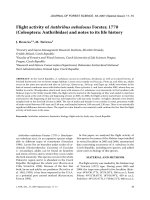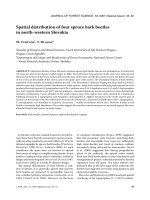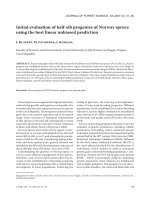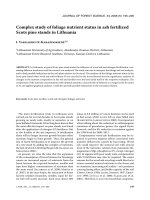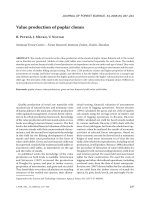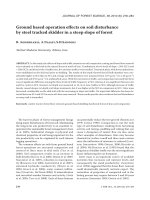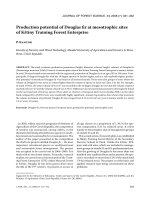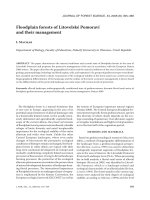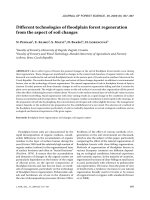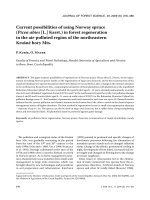Báo cáo lâm nghiệp: "Energy consumption of a chipper coupled to a universal wheel skidder in the process of chipping wood" pptx
Bạn đang xem bản rút gọn của tài liệu. Xem và tải ngay bản đầy đủ của tài liệu tại đây (872.3 KB, 7 trang )
34 J. FOR. SCI., 57, 2011 (1): 34–40
JOURNAL OF FOREST SCIENCE, 57, 2011 (1): 34–40
Energy consumption of achipper coupled to a universal
wheel skidder in the process of chipping wood
J. K, J. K, M. M
Department of Forest and Mobile Technology, Faculty of Environmental and Production
Technology, Technical University in Zvolen, Zvolen, Slovakia
ABSTRACT: The chipper for chips is an energy consuming machine. Many factors influence the result of chipping
which influence the whole process. The paper deals with the process of wood chipping by achipper in order to deter-
mine its energy consumption. The main purpose was the determination of input power and comparison of revolution
frequency on the outlet shaft of a skidder regarding the dimension of the torque depending on variable parameters
which characterize the process of wood chipping during the measurement and the analysis of energy consumption of
a chipping machine was carried out.
Keywords: chip; chipper; chipping; energy consumption; power of cutting
Chipping machines are used for the process-
ing of inferior wood and wooden waste like waste
from sawing which are produced by the processing
of whole tree stems for assortments in the forest or
main wood stocks and waste from timber produc-
tion (e.g. branches, tree stumps, coniferous topwood,
etc.) Output products of these machines are small
particles of wood called chips. Chip production can
run directly in the scrub, on the skid road and in the
factory. ese are input materials for subsequent in-
dustrial delimbing, e.g. in chemical industry for the
production of cellulose and paper, in wood-process-
ing industry for the production of chipboards and
fibreboards and in power industry biomass (fuel) is
used for the production of heat ( 2001).
According to the purpose the chip will be used for
it must have required dimensions and shape. For the
production of fibreboards the fibres should be from
20 to 30mm in length and from 3 to 5 mm in width.
For the production of brown coal the chips should
have the length from 80 to 120 mm. e length of
chips is given by the type of grate in the furnace and
stoking equipment in automatic burning machines. If
the chips are blown, the required length is from 6 to
10 mm. If there is a mechanical transport of chips, the
required length is from 12 to 20 mm. In the chemical
processing of chips by a sulphite process the length
of chips from 20 to 30 mm and the thickness from
3 to 6 mm are recommended. In a sulphate process
the length of chips is from 10 to 25 mm and the thick-
ness from 3 to 5 mm (STN 48 0057; STN 48 0058).
In practice we can find more names of these ma-
chines like chipper, cutting machine and grinder of
wooden mass. All these names are characteristic of a
machine which uses mechanical way of cutting knives
for taking small particles from wood and it is called a
chip. Chipping machines are machines for the chip-
less cutting of wood by a knife across the fibres and
also for necessary thickness along the fibres. Nowa-
days, there are more and more people who know that
chipping is a real way of wooden mass utilization and
that it enables to obtain the pureness of forest.
Technological operations which prevent waste
wood utilization involve timber production, con-
centration into lines, skidding to transporting plac-
es, its dimensional homogenization, e.g. chipping,
grinding, etc. Wood for energy production can come
from either waste from technological processes of
wood production and primary wood processing or
goal-directed production of fuel wood.
eoretical principles of wood chipping
by a chipper
First, we have to say that wood chipping is a very
difficult process. is is the reason why simplifying
J. FOR. SCI., 57, 2011 (1): 34–40 35
assumptions are used for its solution. is method
is also used for chipping by disc and drum chip-
pers. As mentioned above, it is about combined
cutting by a flat knife with one cutting edge. e
principle and the scheme of cutting by a disc chip-
per are shown in Fig. 1. e knife with cutting edge
angle β, which is fixed on a rotating disc, cuts from
wood the layer of thickness a. e slotted hole is
leaned against the second knife during cutting. e
cut layer is disintegrated into chips of required di-
mensions (of length l and thickness h).
e basic factors which influence the proper-
ties of chips and specific consumption of energy
in the process of chipping wood, except technical
parameters, are also the type, moisture and qual-
ity of wood, lock and cutting angle of knives, angle
of the contact, cutting speed, length of the slotted
hole and feeding speed of wooden mass at chipping
(B 2001).
e cutting tools, i.e. knives in chippers, work
discontinuously and are much stressed. e quality
and efficiency of chip production depend directly
on the state and hardness of their cutting edges.
e cutting knife is characterized by the material
and by an angle of the cutting edge β. Very impor-
tant is also the value of overhang from the plane of
the disc in the process of step on the disc and work
with a gradual change of the radius for the cutting
edge of the knife. Knives for chippers should be
made explicitly from homogeneous and unclad ma-
terial. Steel for the production of cutting tools must
have mainly high hardness, stability of the cutting
edge regarding the abrasive action and blunt-
ing and it should have adequate toughness. ese
properties are fulfilled by some types of tool steels
(19,132; 19,559; 19,732). When the cutting angle
is decreased, the number of thin, long and under-
sized chips is lower. When the angle of blunting is
increased, there is a higher share of dust and the
sharpness of cutting is decreased. e overhang of
knives from the plane of the disc defines the prede-
termined length of chips, which directly influences
the length of chips (Š et al. 1964).
According to Lisičan there are ordinary values of
angular knife parts (α, β, δ) defined from the fol-
lowing criteria:
– kinematic (α)
– technological (β)
e kinematic point of view defines a possibility
of the log feed to the disc also during the activity of
the knife, i.e. not only in the position of a log situ-
ated between two knives. is is the reason why the
cutting clearance angle α should be minimum:
[ ]
°=
str
R
hz
arctg
2
.
1
min
π
α
(1)
where:
z – No. of knives,
h
1
– overhang of the cutting edge from the plane of
the disc (mm),
R
str
– distance from the disc rotation axis to the half
length of the cutting edge of the knife (mm).
e technological point of view (disintegration of
wooden mass into “chips”) is defined by the ther-
mal state and type of wood. Approximately:
β
optim
≅ 37° ⇒ in summer time
β
optim
≅ 39°–40° ⇒ in winter time
e incorrect setting of knives, i.e. the distance
between knives is too big (3–5 mm), can cause
that cutting is not smooth but in the place of cut-
Fig. 1 e tilt-angle of a knife in
a chipper disc at high and low
number of revolutions in a chip-
per (L et. al 1996)
arctg
z ×h
1
2π × R
str
Fig. 1 The tilt-angle of a knife in a chipper disc at high and low number of revolutions in a
chipper (Lisičan, 1996)
Fig. 2 The scheme of wood chipping by a disc chipper (Štempel, 1964)
1-chipping knife; 2-disc; 3-chipped section; 4- down-ga te; 5-counter knife; 6- chip.
4 mm
0.2–0.6 mm
36 J. FOR. SCI., 57, 2011 (1): 34–40
ting there are bend and drafting between knives
and it leads to the production of too big chips. If
the distance between knives is defined correctly
(0.2÷0.6 mm), then the knives work like scissors
and clean cut is produced (L 1996).
If the cutting out a layer occurred, the knife
would have to act on wood by total force F
c
. is
force acts in the trajectory of the knife movement
and it is defined by the sum of forces F'
o
and F'
R
.
e part F'
o
creates the force F'
o
, which acts in the
direction of wood fibres. It is necessary for the sep-
aration of chips from the wood layer. e partF'
R
creates the force F
R
acting perpendicularly to the
fibres and because of this action the cut of wood fi-
bres occurs. In Fig. 2 the decomposition of forceF
R
is shown. e friction between a slotted hole and a
loading inlet is caused by the force F
R
. e part F''
R
presses the slotted hole to the knife. Its course is
opposite to friction. It is caused by a feed effect, it
means that the stem is pressed to the disc by itself
(O 1996).
To separate the chips the condition that α > β
must be met, it means that the force FT is positive.
Otherwise if α < β, the chips will be pressed to the
part of the stem which was cut. e angle α is the
final angle of the loading inlet, which is defined by
angles α
1
and α
2
(M et al. 2004).
ere are many factors influencing the result of
chipping, e.g. the shape and position of a loading
inlet, shape and setting of knives, number of knives
on a disc and also the shape of a disc. is is the
reason why the optimal dimensions are looked for
from the aspect of correct chipping and they are
looked for experimentally and the machines are
constructed according to experimental conditions
(Š et al. 1964).
Fig. 2. e scheme of wood chipping by a disc chipper (Š 1964)
1 – chipping knife; 2 – disc; 3 – chipped section; 4 – down-gate; 5 – counter knife; 6 – chip
Fig. 1 The tilt-angle of a knife in a chipper disc at high and low number of revolutions in a
chipper (Lisičan, 1996)
Fig. 2 The scheme of wood chipping by a disc chipper (Štempel, 1964)
1-chipping knife; 2-disc; 3-chipped section; 4- down-ga te; 5-counter knife; 6- chip.
Fig. 3 Connection of
the chipper Pezzolato H
780/200 to the skidder Ze-
tor 5341
1 – torque sensor;
2 – gravimetric measure-
ment of fuel
Fig. 3 Connection of the chipper Pezzolato H 780/200 to the skidder Zetor 5341
1. Torque sensor, 2. gravimetric measurement of fuel.
0,00
100,00
200,00
300,00
400,00
500,00
600,00
700,00
800,00
900,00
0,00
0,64
1,28
1,92
2,56
3,20
3,84
4,48
5,12
5,76
6,40
7,04
7,68
8,32
8,96
9,60
10,24
10,88
11,52
12,16
12,80
t (s)
Mk (N.m), n (min 1)
n [min 1] Mk [N.m] Trendline Mk
Fig. 4 The course Mk and n at chipping where the thinner part of a b ra nc h wa s used
(beech)
1 2
J. FOR. SCI., 57, 2011 (1): 34–40 37
only for breaks during chipping between two logs.
During breaks kinematic energy is accumulated
in the rotor of a chipper (this is called START),
it relieves the work of the motor, i.e. revolutions
decrease during the cutting of a log from n
1
to n
2
and during the break between two logs revolutions
increase again to n
1
. is effect is used for con-
structing the whole power of the motor (L
et al.1996).
MATERIAL AND METHODS
A Pezzolato H 780/200 overhung chipper coupled
to a three-point linkage Zetor 5341 skidder (Fig. 3)
was used for the research of parameters. e chip-
per is driven from the output shaft of the skidder.
is version of the machine is equipped with se-
quentially driven horizontal hydraulic cylinders
which are secured by a hydraulic security system
against impacts. e maximum diameter of disin-
tegrated material is 200 mm. e other basic char-
acteristics of this material are shown in Table 1.
e Zetor 5341 skidder was equipped according to
the chipper producer’s instructions. e minimum
required power of the motor is 30 kW. e power
of the skidder is 47 kW at 2,200 min
–1
. e revolu-
tions on the outlet shaft are n = 580 min
–1
without
loading.
Two types of wood in three assortments were
used which are widely used and spread in the Slo-
vak Republic. Softwood (spruce) and hardwood
(beech) were used. ree types of assortments were
used for measurements, i.e. brushwood (branches
up to 5 cm in diameter), wood up to 8 cm in diam-
eter and 2 m in length and round timber 12 cm and
20 cm in diameter and 2 m in length. e samples
for chipping were directly cut from intermediate
Table 1. Technical parameters of the chipper Pezzolato
H 780/200
Loading inlet dimensions
(mm)
860 × 630
Disc diameter (mm) 780
No. of knives (pcs) 3
Max. No. of disc revolu-
tions (min
–1
)
1,000
Length of chips (mm) 6–18
Flywheel diameter (mm) 200
Max. inlet dimensions
(mm)
230
Required power (kW) min. 30
Shaft revolutions (min
–1
) 540
Power of a motor (kW) 37
Performance of a machine
per hour (m
3
·h
–1
)
14–18
Dimensions with a shaft
[w × l × h]* (mm)
2,900 × 1,800 × 2,750
Weight with a shaft (kg) 850
Dimensions of discs 5.5 J × 13
Dimensions of tires 175/70 – R13
Pressure in tires (bar) 3.0
Max. transport velocity
(km·h
–1
)
20
*with an exhaust pipe in transport position
e chipper for chips is a machine with high
energy consumption. is is the reason why it is
necessary to use the kinematic energy of flywheel
mass for overcoming the resistance of wood and to
choose a higher number of knives on the disc (two
knives in work at the same moment) to decrease
impacts in electrical network or to eliminate them
0
100
200
300
400
500
600
700
800
900
t (s)
Mk (N.m), n (min
–1
)
n [min
–1
] Mk (N/m) Trendline Mk
0.00
0.52
1.06
1.56
2.08
2.60
3.12
3.64
4.16
4.68
5.20
5.72
6.24
6.76
7.28
7.80
8.32
8.84
9.36
9.88
10.40
10.92
11.44
11.96
12.48
Fig. 4. e course Mk and n
at chipping where the thin-
ner part of a branch was used
(beech)
(min
–1
)
or removal felling. e moisture was measured by
a weight method. e moisture of spruce was 61%
while the moisture of beech was 44%.
e measurement consisted in scanning the
torque and revolutions on the outlet shaft with an
HBM T10 scanner with output to the evaluation
device SPIDER 8 and this information was record-
ed to the computer hard disc using the software
program Conmes Spider. e measured results
were statistically processed on a personal com-
puter which was equipped with the statistical pro-
gramme STATISTICA and fuel consumption was
determined by a weight method (K 2008).
RESULTS AND DISCUSSION
e main objective of the experiment was to de-
termine power and to compare the frequency of
rotation on the outlet shaft of the skidder in the
process of chipping regarding the torque depend-
ing on measurement parameters characteristic of
the process of cutting wood (K 2009).
e energy used for cutting wood was supplied
by the motor during caracole and by the rotor
in consequence of the revolution decrease. e
torque of the rotor consists of the disc torque, shaft
torque and cardan shaft torque. e other rotating
parts are not important due to low weight. e av-
erage no-load input of the chipper was established
as 4.09 kW. e no-load input was evaluated and
controlled individually before each attempt in the
experiment. en the no-load input before each at-
tempt has the value of 4.09 kW.
e value of the torque varies during the chip-
ping process along the stem of the tree. It increas-
es or decreases with the frequency of chipping
disc revolutions. e values Mk and n increase
38 J. FOR. SCI., 57, 2011 (1): 34–40
0
100
200
300
400
500
600
700
t (s)
Mk (N.m), n (min
–1
)
n (min
–1
) Mk (N/m) Trendline Mk
9.15
9.92
10.7
11.4
12.2
13.0
13.7
14.5
15.2
16.0
16.8
17.5
18.2
19.0
19.8
20.6
21.3
22.1
22.8
23.6
24.4
25.1
25.9
26.6
27.4
Fig. 5. e course Mk and
n at chipping where the
thicker part of a branch
was used (spruce)
Fig. 6. 95% of dependability intervals for
mean values of power for all factors which
influences of angles are emphasized
P (kW)
Assortment
Assortment
angle: 35
angle: 36
Timber: Beech Timber: Spruce
5
5
8
8
12 12
20
20
50
45
40
35
30
25
20
15
10
5
or decrease according to the way of putting stems
into the chipper, i.e. if thick (Fig. 4) or thin ends
(Fig. 5) are introduced to the loading inlet hole.
is change is proportional to a change in diameter
along the treated assortment and presence of wood
defects. Power parameters were tested in connec-
tion with the type of wood, assortment and the an-
gle of the clearance face. e energy consumption
was analyzed from two measurements (two types
of chipping knives) after realization and analysis of
preparatory measurements. e power found out
on the output shaft of the Zetor 5341 skidder with
Pezzolato H 780/200 chipper varies linearly with
the change in the assortment and it has the highest
influence on power. e power varies from 9 kW to
47 kW (these maximum values are calculated from
the measurement record).
ANOVA (multifactor analysis of variance) was
used for finding out the interaction of several fac-
tors with energy consumption of the chipping pro-
cess. e criteria used for the analysis were maxi-
mum torque, maximum revolutions and maximum
power. As criteria of statistical significance (P)
F-test was used and it is probability of the fact that
the factor does not have a statistical influence. A
reciprocal statistical dependence was found out
between the maximum power (dependent variable)
and wood, assortment and knife angle (independ-
ent variables). ere was an assumption that the
particular parameters influenced each other. For
the test generalization Duncan’s test was used.
For each variation of three-factor levels (4 assort-
ments × two types of wood × two different knives
= sixteen variations) there was filtered out repre-
senting interval of values tested items (n, Mk, P).
For each physical item the results were statisti-
cally evaluated by three-factor analysis of variance
(K, M 2008).
Based on the monitored factors, the following
results were obtained: the assortment has the sta-
tistically most significant influence, followed by the
type of wood and knife angle. It is documented in
Figs. 6 and 7, where 95% reliability intervals for me-
dians of power take place.
Based on the statistical interpretation, maximum
average energy consumptions in beech and spruce
assortments are visible which were calculated from
the measured physical parameters of torque and
revolutions on the outlet shaft. In the statistical in-
terpretation the maximum average value of power
is 42.43 kW (beech – round timber up to 20 cm, the
cutting clearance angle is 36°) and the minimum is
11.85 kW. e graphs illustrate that the maximum
energy consumption of the chipper was determined
when assortments up to 20 cm in diameter were
used. We can state on the basis of maximum aver-
age values that the power-driven means (skidder) is
suitable for a certain adapter (chipper) and for the
chipping process of nonstandard wood.
References
B J. (2001): Chemical Wood Processing in eory and
Practice. Zvolen, Technical University in Zvolen: 427. (in
Slovak)
K J. (2009): Research of energetic consumption of a
chipping machine for disintegration of biomass, In: XI.
J. FOR. SCI., 57, 2011 (1): 34–40 39
Angle: 35
Angle: 36
Fig. 7. 95% of dependability intervals for
mean values of power for all factors which
influence of wood is emphasized
Assortment
Assortment
5
8 8
12
12
20
20
5
P (kW)
50
45
40
35
30
25
20
15
10
5
timber: Spruce
timber: Beech
40 J. FOR. SCI., 57, 2011 (1): 34–40
International Conference of Young Scientists. Zvolen,
Technical University in Zvolen: 100–107. (in Slovak)
K J. (2008): Research of energetic consumption of the
chipper for disentegration of nonstandard wood. In: Al-
manac to grant project No. 1/3534/06. Zvolen, Technical
University in Zvolen: 55–63. (in Slovak)
K J., M M. (2008): Energetic consumptions of a
chipper at disintegration of wood. Acta Facultatis Tech-
nicae 12, 49–58. (in Slovak)
L J., S M., Z B. (1996): eory
and Technology of Wood Processing. Zvolen, Matcentrum:
626. (in Slovak)
M M., H J., M J. (2004): Forest machines.
Zvolen, Technical University in Zvolen: 330. (in Slovak)
O A. (1996): Wood Chipping by Disc Chippers.
Zvolen, Technical University in Zvolen: 34. (in Slovak)
Š Z., J J., P J., P J. (1964): Chip-
ping Wood and Chippers. Bratislava, SVTL: 216. (in Slovak)
STN 48 0057 (2004): e Wood Assortments, e Coniferous
Wood Chips and Sawdust. (in Slovak)
STN 48 0058 (2004): e Wood Assortments, e Hardwood
Chips and Sawdust. (in Slovak)
Received for publication March 4, 2010
Accepted after corrections July 2, 2010
Corresponding author:
Ing. J K, Ph.D., Technical University in Zvolen, Faculty of Environmental and Production Technology,
Department of Forest and Mobile Technology, T.G.Masaryka 24, 960 53 Zvolen, Slovakia
e-mail:
